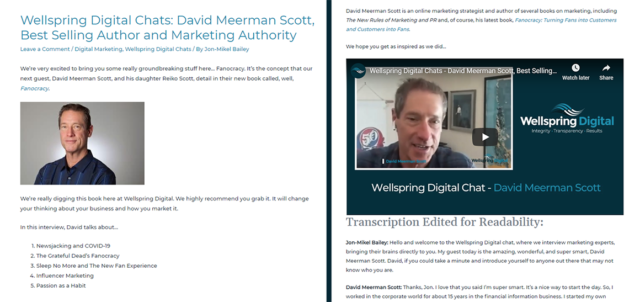
What do you think when you see the word “content?” Do you break out in a cold sweat? Glaze over? Or think “someone else handles that?” Content marketing is real, it’s being done every day all over the world, it can improve your bottom line and your reputation, and there’s even a Content Marketing Institute!
Writing is hard, don’t let anyone tell you otherwise. Ann Handley, the Chief Content Officer and author of Content Rules and Everybody Writes, will be the first to tell you that writing is hard.
Creating something out of nothing can be difficult. The inspiration may not be there or you may feel like you’ve said all there is to be said. Trust me, you don’t need divine inspiration and you haven’t said all that needs to be said… to your target audience.
Rethinking What “Content” Means
I’ve seen the life drain out of people when I start talking about their content. I think it’s because they associate the word “content” with hard work. In the marketing world, we’ve pushed this narrative that content is king AND that content is hard work.
These things are both true but the hard work can be a bit of a self-fulfilling prophecy. If you look at content as nothing more than a chore you have to do, you will hate every minute of it. And this will come through in the content you create.
Your customers want to feel your passion, empathy, and personality come through in any content you give them. They want to know that you’re excited about what you do, and they want to feel that you truly care about their needs.
I hear you thinking “this sounds great, Jon, and it also sounds like a lot of work.” It doesn’t have to be as hard as it sounds.
Bad Content vs. Good Content
There’s tons of good and bad content out there about good and bad content (so meta), I don’t want to offer another retread of that. But, I’d like to offer a baseline before I give you any solutions.
So, with that said, first, a quick rundown of what content shouldn’t be…
- A series of words put together and placed on your website for the sole purpose of ranking for a specific keyword
- 300-word posts that offer little to no value
- 2,000-word posts that drone on in corporate speak and industry jargon
- A sales pitch
- Your corporate resume, all about you
- A retread of the same tired old ideas
What does good content look like? It looks like a solution to a problem…
- A how-to post
- Posts, videos, podcasts making sense of a complex topic
- Timely and useful information
- Content that speaks to your audience, not at them
- Information your audience will thank you for
Marketing is different today. The pitch, the shill, and the corporate-speak are going to hurt you. Make content your audience will thank you for! How? Glad you asked…
Dial-in Your Content Marketing Radar
Wanna know what kinds of content your audience wants? Well, you can certainly ask them. Don’t worry, I’m not suggesting you put out a survey every time you fill in your next month’s editorial calendar.
They’re telling you already. You don’t even have to ask. (I highly recommend Marcus Sheridan’s They Ask, You Answer)
Content Ideas in Email and Conversations
Your clients, fans, and brand ambassadors are an inexhaustible source of content ideas.
How many emails do you think you respond to every day? How many casual conversations are you having with clients every day? If you’re like the people I know, it’s a lot. There’s great stuff in those interactions.
For example:
- Questions you answer in emails – the answer is a post in the making, take that answer and repurpose it.
- Back and forth with staff – use this as the basis for a point/counterpoint or a deeper dive into a topic.
- Customer service phone calls – ask your customer service people to log the complaints, use them as the post topic.
- Conversations in the office – are there gems you’re holding hostage? Let your audience in on the discussion with a live video or post with customer comments.
As you can see, ideas and the beginning of good content is right in front of you every day. Never assume that your audience has the same access to these topics and discussions that you do. They are counting on you to share the important stuff with them.
Content Ideas in the World around You
Once you’ve sharpened your content radar, you will also find inspiration for new content in the world around you. Start looking at things through the lens of “why does this matter in my industry,” or “is there a way to use this to explain a concept or tell a story?”

Social media audiences are notorious “scanners” meaning they don’t read everything that’s in front of them, they scan. In her book, InstaBrain: The New Rules for Marketing to Generation Z, Sarah Weise tells an interesting story about observing someone from Gen Z scrolling through their Instagram.
At first, it seemed that this person was just mindlessly scrolling through an endless stream of Instagram posts. But, eventually what she found was that they were actually quickly looking for something that caught their eye.
Once they stopped on something, what happened next was amazing. They did a very deep dive into the subject of what caught their eye. And this was true for most in Gen Z. When something got their attention, they would spend hours learning everything they could about that thing.
I bring up this story because I think it shows the importance of creating content that demands attention. And, if you create posts about relevant and popular topics, your chances of getting noticed increases. This applies to all generations.
Newsjacking
Shift your focus to find inspiration in trending topics like news stories. Can you do some newsjacking with those news stories?
According to the Oxford Dictionary, Newsjacking is defined as…
“The practice of taking advantage of current events or news stories in such a way as to promote or advertise one’s product or brand.”
David Meerman Scott talks about newsjacking in this recent interview we did with him. It’s a concept he popularized years ago and it is still relevant today, specifically around the topic of this pandemic, social distancing, and COVID-19.
Find a unique angle to the story and how it relates to your industry. For example, in the marketing world, tons of conferences are being postponed or canceled. So, a lot of marketers out there are using this to talk about how to do virtual events.
I’m also seeing IT companies using this when they’re putting out posts about the implications and best practices for remote workers. I’ve seen posts about security concerns and posts about the logistics of setting up a home office.
Just make sure you aren’t exploiting a topic. It needs to respect the original topic. So, if the topic is a very serious one, avoid making light of it. This makes you appear insensitive and tone-deaf.
Trending Topics and Hashtags
Another source of inspiration can be found in the place where we all spend tons of time, social media. Pay attention to what people are talking about.
What topics are driving lots of engagement? What topics are “trending” on the social channels where your audience spends their time? Can you tap into that?
To go even deeper, can you include an influencer in your post and then tag them when sharing the post on that channel? Or better yet, can you bring in an expert to offer their perspective on this topic?
For example, we do our Wellspring Digital Chats. We find experts in the marketing field and do a Zoom interview with them. I take the video from this interview and load it onto YouTube (the 2nd most popular search engine which happens to be owned by… Google).
Then, I embed that video in a blog post and include the transcription below. We use Otter.ai here for transcriptions (thanks again Chris Penn!!). If you’re anything like me, you’ll want to edit the transcription because machines can only get it so right.
It looks like this…

Of course, the video takes some extra work. If you do not have time to do video editing, try just recording the audio and then posting that and the transcription in the post.
Or you can take the transcription and break it up into multiple posts, making it a series.
Smarter Content Marketing
I could go on and on. In fact, I did in a presentation for the Frederick County Chamber of Commerce.
The point of this post is to get you thinking about content differently. Content is not something you should fear. Content is the conduit through which you form stronger relationships with your clients, fans, and brand ambassadors.
Shift your focus and make sure your content idea radar is always on. I think you’ll be amazed at how much inspiration there is all around you.
And remember, no one piece of content is an island unto itself. Squeeze every last drop out of each piece of content:
- A post becomes a series
- A series becomes a presentation
- The presentation becomes an eBook
- The eBook becomes a video
- Then the video becomes a Podcast and blog post
There is always more you can do with an idea. Exhaust everything, waste nothing. Your audience will love you for it, your site will be more popular and productive, and your bottom line will improve.
Of course, if you are completely swamped and have zero time, I get it. Work with a team of professionals to up your content game. Wellspring Digital has great content marketing service offerings.
Drop us a line or give us a call (301.383.8351) if you need any help with your content marketing.